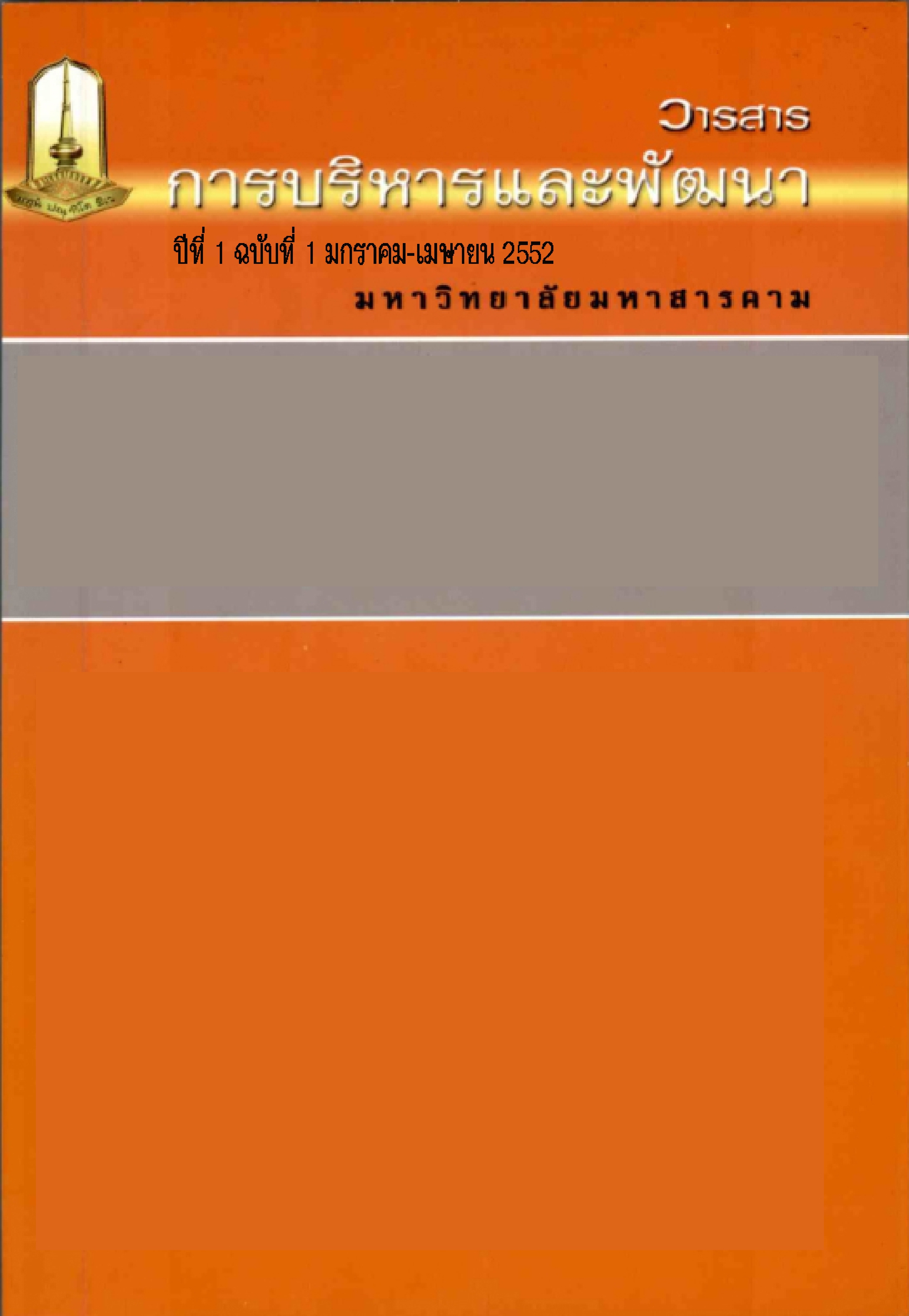Ban Phu, the Sufficiency Economic Community : To Action Learning
Main Article Content
Abstract
This study aimed to examine the implementation of the philosophy of sufficiency economy to action learning at Mu Ban Phu, Amphoe Nong Sung, Chang wat Mukdahan by using the focus groups there were to tally 15 knowledge managers. The instruments used were a survey form and an interview form on basic data and data involving operation of the suffi- ciency economic village. The results revealed that Ban Phu was a village or a community with a guideline for development to sustainable self-reliance by upholding the royal statement "sufficiency economy". This included forming different groups in the community with strengths and being important synergy of the community to sustain able development such as there were forming groups for careers and reduction of the uses of agricultural chemicals; there were community economic systems from the bases of knowledge/indigenous knowledge as generated from connection and helping different activities get together until synergy was generated and could drive together by themselves. It was the way of self-reliant, nature- reliant, and among-people-reliant community. There was participatory learning among villag- ers in the community. The implementation of the philosophy of sufficiency economy to action learning of Ban Phu village operated the following different activities: (1) In expense reduction activity, expense reduction was regarded as the beginning activity of operation according to the philosophy of sufficiency economy. The community operated these activities for expense reduction: raising animals and plants for household consumption, production and uses of organic fertilizers and biofertilizers for agriculture, the uses of seeds and animals promoted by the government, the uses of raw materials available in the community for goods production. (2) Income increment activity comprised making household supplementary careers, forming career groups. (3) Savings activities had these significant principles: spending 3 parts and saving 1 part. (4) Activities for living worthwhile by making community plans by having village members have participation, plans for development of basic factor and monthly village development. (5) For natural and environmental conservation activities, the importance of keeping nature and environment very well was given because there have been commitments with forests from ancestors, making plans for natural and environmental conservation, and operating according to the plans. (6) Activities for assistance had help and sharing in the community. Assistance, help and sharing were what could been always seen in this commu- nity. Living still uphold the principle of sharing food and agricultural products among neigh- bors and relatives like brothers and sisters who helped one another.
Downloads
Article Details
References
กรมการปกครอง กระทรวงมหาดไทย. (2541). การพัฒนาเศรษฐกิจพึ่งตนเอง. กรุงเทพฯ: โรงพิมพ์ส่วนท้องถิ่นการปกครอง.
กุศล รักษา. (2539). การนำนโยบายการพัฒนาเศรษฐกิจชุมชนพึ่งตนเองไปสู่การปฏิบัติขอ ผู้นำชุมชน กรณีศึกษา:อำเภอวัฒนานคร จังหวัดสระแก้ว. วิทยานิพนธ์ ศศ.ม. กรุงเทพฯ: มหาวิทยาลัยรามคำแหง
ฉลาด จันทรสมบัติ. (2551). เอกสารการสอนชุดวิชาการจัดการศึกษาเพื่อพัฒนาท้องถิ่น. พิมพ์ครั้งที่ 2.มหาสารคาม : อภิชาติการพิมพ์.
สมบูรณ์ บุติมาลย์. (2548). การพัฒนาบุคลากรในการดำเนินเกษตรแบบเศรษฐกิจพอเพียง ตามแนวพระราช-ดำริทฤษฎีใหม่ โรงเรียนบุแกรงวิทยาคม อำเภอจอมพระ สำนักงานเขตพื้นที่การศึกษาสุรินทร์ เขต 1.การศึกษาค้นคว้าอิสระ กศ.ม. มหาสารคาม: มหาวิทยาลัยมหาสารคาม.
สรรเสริญ วงค์ชอุ่ม. (2544). เศรษฐกิจพอเพียง พื้นฐานสู่การพัฒนาที่ยั่งยืน. กรุงเทพฯ: คณะสังคมสงเคราะห์ศาสตร์ มหาวิทยาลัยธรรมศาสตร์.
สำนักงานคณะกรรมการพัฒนาการเศรษฐกิจและสังคมแห่งชาติ. (2548). เศรษฐกิจพอเพียงคืออะไร ?.พิมพ์ครั้งที่ 2.กรุงเทพฯ: คณะอนุกรรมการชับเคลื่อนเศรษฐกิจพอเพียง สำนักงานคณะกรรมการพัฒนาการเศษฐกิจและสังคมแห่งชาติ.
สำนักงานคณะกรรมการพัฒนาการเศรษฐกิจและสังคมแห่งชาติ. (2549). แผนพัฒนาเศรษฐกิจและสังคมแห่งชาติฉบับที่ 10 (พ.ศ. 2550-2554). ค้นเมื่อ 28 สิงหาคม 2551, จาก htp://www.nesdb.go.th/plan10/index.htm.
สุภางค์ จันทวานิช. (2542). การวิเคราะห์ข้อมูลเชิงคุณภาพ. พิมพ์ครั้งที่ 2. กรุงเทพฯ: สำนักพิมพ์แห่งจุฬาลงกรณ์มหาวิทยาลัย.


